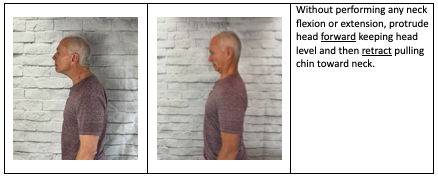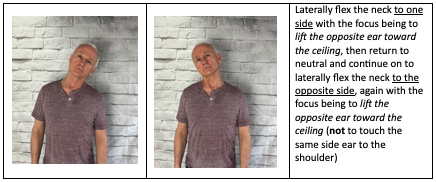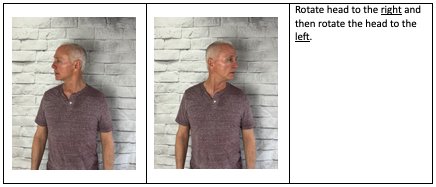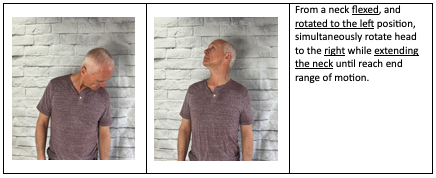 24th Jun 2024
24th Jun 2024
What is CROM and How Can I Maintain My Neck ROM?
When we move our head and neck, that movement is occurring at the vertebral facet (articulating processes) joints between the cervical spinal segments (C-1 to C-7) and also at the atlanto-occipital joint where the two occipital condyles of the occipital bone of the skull articulate with the superior articular facets of the atlas (C1). When movement occurs between the vertebral facets of the cervical vertebrae it is a neck movement. When movement occurs between the occipital condyles of the skull and the superior articular facet of atlas (C1) it is a head movement. Of course, these usually occur in unison when performing normal movements.
Movement at these joints allow us to move our head/neck in three planes of motion – sagittal, frontal, and transverse. Our ability to move properly in all three planes of motion provide us with the ability to effectively turn our heads from side to side, bend them laterally toward the right and left, and to look up and down. Consider the importance of these movements in routine daily activities such as turning our heads when driving to see traffic, looking down to see something on the ground, laterally bending to obtain a better view requiring a different slant, or literally many other daily activities or those required in the realm of sports performance. Lacking in any range of motion of the head and neck could increase injury risk, limit mobility and therefore activity, and adversely affect our quality of life.
Healthcare personnel and therapists may use a Cervical Range of Motion device known as CROM. This device is worn on a patient’s head and uses inclinometers and magnets to measure, in degrees, cervical joints (and yes atlanto-occipital joint) range of motion accurately and objectively as a patient moves his or her neck/head through all planes of motion.
For what purposes might a therapist use a CROM on a patient?
There are a variety of mechanisms whereby we might injure our necks, ranging from an event like an automobile accident to sleeping in a “weird” or abnormal head placement position. Some surgical procedures may leave the neck with range of motion restrictions. In all these circumstances tissues may become damaged, irritated, and inflamed and restrict normal range of motion.A therapist may perform manipulation and mobilization techniques combined with exercise and active movement to treat such conditions. Further, cervical range of motion screening using a CROM device is often performed on a patient to determine the degree of inhibited range of motion and to monitor the patient’s progression overtime. This provides the healthcare practitioner to set goals and evaluate the effectiveness of therapeutic interventions to restore normal and healthy range of motion to the cervical region. In many cases, this type of documentation may be required by third-party insurance payers for coverage to be granted.
What are the unique advantages of a CROM measurement?
- CROM devices come with standardized protocols to minimize the chance for examiner error and demonstrate a high degree of interrater reliability and reproducibility
- The CROM is designed with AMA-required inclinometers and magnets that effectively measure range of motion
- The lightweight, comfortable to wear, and anatomically secure placement with Velcro straps eliminates slippage, positioning, zeroing, and tracking errors common with stand-alone inclinometers, and allows cervical rotational movements to be assessed in the upright position
- The CROM device is the only assessment tool for which normal values have been established for healthcare professionals assessing patient cervical range of motion
What strategies can I take personally to help maintain normal cervical range of motion?
There are various rehabilitative strategies that might be used to correct and heal damaged tissues that may be affecting cervical range of motion. Below are a series of neck movements that when performed consistently can help to overcome muscle (those crossing or acting on the neck) stiffness, facilitate proper cervical/neck joint sliding motions (known as arthrokinematic motions), help restore or maintain cervical/neck range of motion, and reduce or eliminate neck pain from a variety of causes.
Preparation: When performing the movements:
- They may be performed sitting or standing
- The trunk should maintain good posture (upright, head straight forward, shoulders slightly back and chest slightly out)
- The patient should move at slow to normal movement speed with the movements made in a smooth and rhythmical manner
- Travel through a full range of motion you currently have while placing some stress at the end ranges to stretch tight tissues
- Perform all the exercises at 10 full reps for each movement. Perform daily or 2x daily – morning and evening.
Movements:
Neck Flexion & Extension in the Sagittal Plane of Motion

Neck Protrusion and Retrusion in the Sagittal Plane of Motion

Neck Lateral Bending Right and Left in the Frontal Plane of Motion

Neck Rotation Right and Left in the Transverse Plane of Motion

Neck Rotation Right and Left in an Oblique (combo Sagittal & Frontal) Plane of Motion






